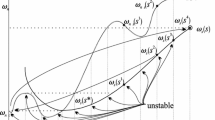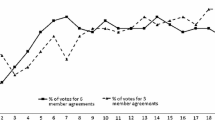Abstract
We study the formation and the stability of International Environmental Agreements (IEAs) in a pollution abatement model with a quadratic cost function. Countries play a two-stage game: in the first stage each country decides to join or not the coalition while, in the second stage, the quantity of pollution abatement is chosen. To analyze the stability of coalition structures in a multiple coalition game, we use the notion of the Largest Consistent Set (LCS) which allows players to be farsighted. Chwe (1994) developed the concept of farsighted stability: an outcome is stable and it is in the LCS if and only if deviations from it or potential further deviations are not unanimously preferred to the original outcome by the coalition considering the deviations. Applying this notion of stability in the IEA context we assume that, when a country or a sub-coalition contemplate exiting or joining an agreement, it takes into account the reactions of other countries ignited by its own actions. The goal of this paper is to identify the resulting stable structures and the LCS, examining the cooperation among countries with respect to an indicator of countries’ environmental awareness. We show that large coalitions are possible outcomes of the game if the farsightedness is considered. In particular, we obtain general sufficient conditions that assure the farsighted stability of the Grand Coalition. In a computational way, we prove that if the environmental awareness is larger than a threshold value, the number of coalition structures belonging to LCS goes down with respect to the initial coalition structures and coalitions with singleton countries never exist. Moreover, we present a useful Maple algorithm to compare the cost functions and to determine direct dominance.
Similar content being viewed by others
References
Barrett S. (1994) Self-enforcing International Environmental Agreements. Oxford Economic Paper 46: 878–894
Biancardi M., Di Liddo A. (2010) The size of farsighted stable coalitions in a game of pollution abatement. Natural Resource Modeling 23(4): 467–493
Biancardi M., Villani G. (2010) International environmental agreements with asymmetric countries. Computational Economics 36: 69–92
Carraro C., Siniscalco D. (1993) Strategies for the international protection of the environment. Journal of Public Economics 52: 309–328
Chwe M. (1994) Farsighted coalitional stability. Journal of Economic Theory 63: 299–325
D’Aspremont C., Jacquemin J., Gadszeweiz J., Weymark J. (1983) On the stability of collusive price leadership. Canadian Journal of Economics 16: 17–25
de Zeeuw A. (2008) Dynamic effects on the stability of International Environmental Agreements. Journal of Environmental Economics and Management 55: 163–174
Diamantoudi, E., & Sartzetakis, E. (2002). International Environmental Agreements: the role of foresight. Economics working papers 2002–2010. School of Economics and Management, University of Aarhus.
Diamantoudi E., Sartzetakis E. (2006) Stable International Environmental Agreements: An analytical approach. Journal of Public Economic Theory 8(2): 247–263
Finus, M. (2003). Stability and design of International Environmental Agreements: The case of global and transboundary pollution. In H. Folmer & T. Tietenberg (Eds.), International yearbook of environmental and resource economics, 2003/4 (pp. 82–158). Cheltenham: Edward Elgar.
Finus M., Rundshagen R. (1998) Toward a positive theory of coalition formation and endogenous instrumental choice in global pollution control. Public Choice 96: 145–186
Eyckmans, J. (2001). On the farsighted stability of the Kyoto Protocol. Energy, transport and environment working papers series, ete 0103.
Greenberg J. (1990) The theory of social situation, an alternative game-theoretic approach. Cambridge University Press, Cambridge
Hoel M. (1992) International environmental conventions: The case of uniform reductions of emissions. Environmental and Resource Economics 2: 141–159
Hoel M., Schneider K. (1997) Incentives to participate in an International Environmental Agreement. Environmental and Resource Economics 9(2): 153–170
Hussen, A. (2004). Principles of environmental economics. Routledge, NY.
Konishi H., Lin P. (1999) Stable cartels with a cournot fringe in a symmetric oligopoly. Keio Economics Studies 36(2): 1–10
Mauleon A., Vannetelbosch V. (2004) Farsightedness and cautiousness in coalition formation games with positive spillover. Theory and Decision 56: 291–324
Osmani D., Tol R. S. J. (2010) The case of two self-enforcing international agreement for environmental protection with asymmetric countries. Computational Economics 36: 93–119
Ray D., Vohra R. (1997) Equilibrium binding agreement. Journal of Economic Theory 73: 30–78
Rubio S. J., Ulph A. (2006) Self-enforcing International Environmental Agreements revisited. Oxford Economic Papers 58: 233–263
Sáiz M. E., Hendrix E. M. T., Olieman N. J. (2006) On the computation of stability in multiple coalition formation games. Computational Economics 28: 251–275
Wietze L., Tol R. S. J. (2004) Attainability of International Environmental Agreements as a social situation. International Environmental Agreements: Politics, Law and Economics 4: 253–277
Xue L. (1998) Coalition stability under perfect foresight. Economic Theory 11: 603–627
Author information
Authors and Affiliations
Corresponding author
Rights and permissions
About this article
Cite this article
Biancardi, M., Villani, G. Largest Consistent Set in International Environmental Agreements. Comput Econ 38, 407–423 (2011). https://doi.org/10.1007/s10614-011-9285-8
Received:
Accepted:
Published:
Issue Date:
DOI: https://doi.org/10.1007/s10614-011-9285-8




